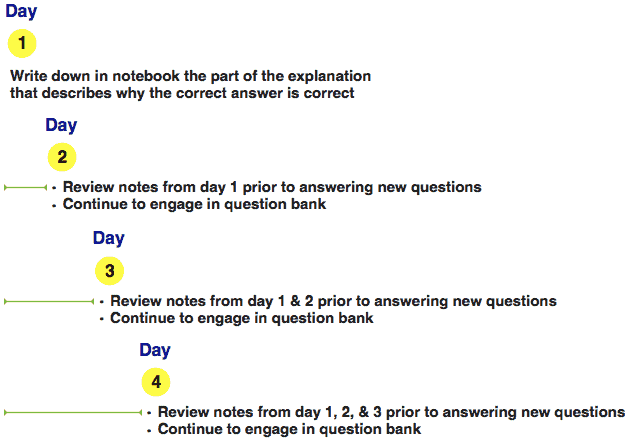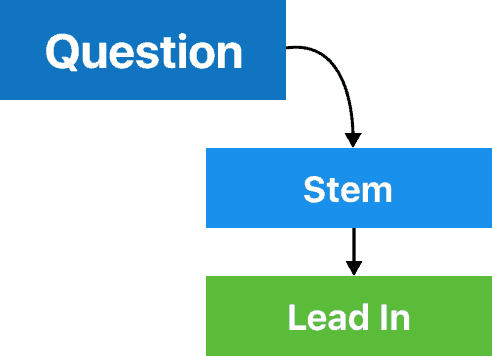How to Increase Your Certified Emergency Nurse (CEN) Exam Score

This article covers two easy strategies to help increase your Board of Certification for Emergency Nursing (BCEN) Certified Emergency Nurse (CEN) exam score. While there is no magic pill or wand that will increase your score, these two techniques are useful, easy to implement, and only require a little of your time.
The first strategy is to identify what you don’t know. Sounds easy, right? The key is to go through a curriculum and identify what you don’t know—not what you are weak at—but what you don’t know. The second strategy is to take advantage of human error. By paying attention to five types of flaws that question writers make, you can narrow down an answer choice to either the correct answer or a 50/50 probability, even without knowing anything about the topic. By combining these two strategies, you’ll be able to increase your CEN exam score, which could be the difference between passing or failing. Let’s get started.
Strategy 1: Determining your unknown unknowns
As you begin to study for your exam, you’ll find that there are areas you are comfortable with. Maybe you have a special interest in electrolyte disorders and feel confident with any question that might be asked on hyperkalemia. Because you are confident in electrolyte disorders, you spend less time reviewing it. This is one of your known knowns. There is little utility in spending too much time on your known knowns when preparing for your exam.
Suppose you feel that your understanding of liver disease remains poor. Hepatic encephalopathy is still just a term to you. You don’t feel confident that you understand how or why it occurs, or how to manage the condition. Liver disease is a known unknown. But because you recognize this specific deficiency, you can target your learning to conditions of the liver.
Once you start to focus your learning, you will come across many concepts and ideas that you may know nothing about. These are the unknown unknowns, a concept created by psychologists Joseph Luft and Harrington Ingham. It is part of their “Johari window,” a tool that helps users identify blind spots about themselves and others.
Known unknowns are things you’re aware that you don’t know—you can recognize that you don’t understand them. Unknown unknowns are unexpected because you don’t know they exist.
The way to supercharge your certification exam score is to identify your unknown unknowns. It takes a little effort, but the steps are rather easy. All you need are two things:

The system works like this:
Step 1: Answer a question from a question bank. If you get the answer wrong, read the explanation. Then write down in your notebook the part of the explanation that describes why the correct answer is correct. This process helps to identify your unknown unknowns. Subsequently, if there is any other information that you did not know or somewhat knew, record it as well in your notebook under the same topic.
You should do this for every question you get incorrect. I also encourage it for questions you may have answered correctly but discovered new information in the explanation that you previously did not know.
Step 2: Start each study session by reviewing your notebook that contains your unknown unknowns. As you do more questions, you will get questions wrong on topics already recorded in your notebook. For example, if you answer a question incorrectly on which age group most commonly gets de Quervain tendinopathy, you’ll record in your notebook something like “de Quervain tendinopathy: Epidemiology includes women between 30–50 yrs old and postpartum.” Two weeks later if you can’t name the diagnostic test characterized by thumb flexion and ulnar deviation of the wrist, you should go back through your notebook to find your first entry on “de Quervain tendinopathy” and add the “Finkelstein test” as the way to diagnose the condition. While we are on the topic, here is a cheat sheet for de Quervain tendinopathy.
After a month or two of recording your incorrect answer explanations, you’ll have a filled notebook of your unknown unknowns and maybe many of your known unknowns. If you do this on a consistent basis and get through 400+ question bank questions for a 175-question exam, you’ll identify most of your blind spots that questions can be asked about. You will convert your unknown unknowns to known knowns.
You can use the same system and process to prepare for all standardized exams.

With the CEN exam waiting for you, now is the perfect time to begin this system. It leaves plenty of time to accumulate your unknown unknowns.
Strategy 2: Taking advantage of human error
Earlier in this post, I mentioned that you’ll need two things to supercharge your standardized exam score: a notebook and time. The notebook you can buy anytime. However, time disappears.
Taking the time to identify your unknown unknowns will prepare you for the exam. However, there are five ways you can improve your score simply by showing up to your exam.
You can use the errors made by question writers to boost your score.
The Anatomy of a Question
First, let’s understand the anatomy of a question.

Question
A 26-year-old patient presents with eye pain and blurred vision after being hit in the eye. Layering of blood is noted across the iris. Which of the following is the most likely diagnosis?
A question is made up of the stem and the lead-in. The stem contains the details of the question such as the clinical presentation, past medical history, and laboratory results. But, the critical part of the question is the lead-in. The question writer uses the lead-in to find out what you know or don’t know about the topic in the stem, and it is also where question writers make errors. By applying basic grammatical analysis, you will be able to identify the correct answer or at least narrow down the answer choices without knowing anything about the topic. Here are our first two tips:
1. Pay attention to grammatical cues.
Grammatical cues: one or more answer choices (distractors) don’t follow grammatically from the lead-in.
Which of the following is consistent with diabetic ketoacidosis rather than hyperosmolar hyperglycemic state?
A. Develops slowly over days to weeks
B. Mortality rate
C. One is more likely to have glucose levels > 800 mg/dL
D. Results in decreased serum bicarbonate
B and C do not follow grammatically from the lead-in. A good test taker can eliminate these.
2. Focus on logical cues.
Logical cues: one or more answer choices don’t logically fit in with the other choices.
A 32-year-old man presents after an industrial accident where his left arm was caught in a press. His left forearm is swollen and tense, and he complains of paresthesias extending into the fingers. Which of the following laboratory abnormalities would be consistent with his injury?
A. 3+ blood with 25–50 red blood cells/hpf on urinalysis
B. Chem-10 panel
C. Hypocalcemia
D. Hypokalemia
A chem-10 panel is not a laboratory abnormality and can be eliminated by a good test taker.
Let’s now focus on answer choices to identify a few more areas where you can gain an edge.
The Anatomy of Answer Choices
QUESTION: A 26-year-old patient presents with eye pain and blurred vision after being hit in the eye. Layering of blood is noted across the iris. Which of the following is the most likely diagnosis?
A. Hyphema
B. Ruptured globe
C. Subconjunctival hemorrhage
D. Traumatic iritis
A is the correct answer.
B, C, and D are distractors.
The lead-in asks about the most likely explanation, so think carefully through each answer option. Here are the answers from most to least correct:
A. Hyphema – Blood in the anterior chamber is classic for hyphema, especially in the setting for trauma.
B. Ruptured globe – Associated with hyphema, but no evidence of reduced intraocular pressure in vignette.
C. Subconjunctival hemorrhage – Usually benign and associated with blood in the conjunctiva, not the anterior chamber.
D. Traumatic iritis – Presents with eye pain, blurry vision, and decreased visual acuity. Blood in the anterior chamber is not characteristic.
Once you understand the goal of the question writer to create answer choices that are supposed to discriminate knowledge, it is easier to exploit technical flaws and improve the odds of getting a question correct.
The following three pointers round out our five tips that can help you answer a question correctly:
3. Look for answer choices containing absolute terms.
Absolute terms: terms such as “always” or “never.” When used in the answer options, these terms usually indicate an incorrect answer because they cannot hold up to scrutiny in all situations.
Which of the following is good practice when caring for a patient who requires placement of leather restraints for safety?
A. Always securing the restraints to the side rails
B. Keeping the restraints in place until the disposition is determined
C. Never leaving one hand free of restraints
D. Reassessing every 5–15 minutes, depending on organizational policy
A and C contain absolute terms “never” and “always.” These should be avoided in answer choices because they are less likely to be true statements.
4. Keep an eye out for a long correct answer.
Long correct answer: the correct answer is longer, more specific, or more complete than the other options.
A 26-year-old woman presents in a manic state and refuses to sit on the stretcher for triage. She begins to scream uncontrollably and tries to pull the curtains down. Which of the following is the best next step in treating this patient?
A. Attempt verbal de-escalation techniques, and if this fails, sedation and restraints may be needed
B. Call security to escort the patient from the emergency department
C. Call the physician for an order for four-point leather restraints
D. Call the physician for an order for haloperidol
Option A is longer than the other options, and it is also the only double option. Item writers tend to pay more attention to the correct answer than to the distractors and write long correct answers that include additional instructional material, parenthetical information, and caveats.
5. Notice when a word repeats.
Word repeats: a word or phrase is included in the stem and in the correct answer.
A 58-year-old man with a history of major depression and post-traumatic stress disorder is having increased difficulty caring for himself. He speaks of experiencing the world as unreal. What is the term for this symptom?
A. Depersonalization
B. Derailment
C. Derealization
D. Focal memory deficit
This question uses the term “unreal” in the question stem, and “derealization” is the correct answer.
Taking the time to identify your unknown unknowns will not only help you prepare for and excel on your exam, it will help you expand your core knowledge. Then, on test day, use the five simple techniques to identify common flaws in questions, which will increase your chances of getting a question correct.estions, which will increase your chances of getting a question correct.
Give these methods a try and let me know how it goes. Moreover, I’d love to hear about techniques you use that I didn’t write about.
And if you’re looking for a CEN exam Qbank…you know where to find one.
Best,
Adam Rosh





Comments (0)